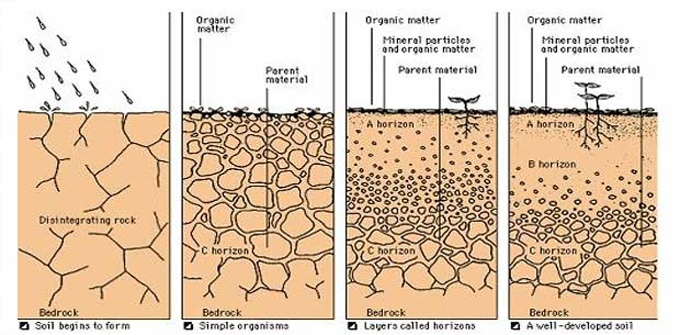
How soil is formed?
Every soil originally formed from parent material: a deposit at the Earth?s surface. The material could have been bedrock that weathered in place or smaller materials carried by flooding rivers, moving glaciers, or blowing winds. Over time, sun, water, wind, ice, and living creatures help transform, or change, the parent material into soil.
Soil stands for the fine layer of material that wraps the surface of the earth. Soil is developed from the parent material like weathering of rocks. It is primarily formed with mineral particles, organic materials, air, water and living organisms?all of which convert or modify the material into soil.
Various factors influence the development of soil which range from variations in temperatures and pressure; erosion and moving by wind, water and glaciers; chemical action like crystal growth, oxidation, hydration, carbonation and leaching by water, specifically rainwater, in due course.
Therefore, the soil is created with the following two methods:
1. Physical disintegration of rocks
2. Chemical decomposition of rocks
Physical disintegration - Physical disintegration or mechanical weathering of rocks because of the following reasons:
1. Variation of temperature: Various minerals of a rock contain numerous coefficients of thermal expansion. Unequal expansion and contraction of these minerals take place owing to temperature variations. When the stresses stimulated as a result of such variations are reiterated several times, the particles are separated from the rocks and the soil formation starts.
2. Wedging action of ice: Water in the pores and small cracks of rocks start freezing in very cold weather because the volume of developed ice surpasses that of water, so expansion takes place. Rocks are splitted into pieces if large stresses produced in the cracks as a result of wedging action of the ice developed.
3. Scattering of roots of plants: The roots of trees and shrubs develop in the cracks and fissures of the rocks, forces operate on the rock. The parts of the rocks are compelled to detach and disintegration of rocks happens.
4. Abrasion: As water, wind and glaciers shift to the surface of rock, abrasion and scouring occurs. It leads to development of the soil.

In each system of physical integration, the chemical composition remains unchanged. The developed soil contains the properties of the parent rock. Course grained soils, like gravel and sand, are created with the method of physical disintegration.
To read the complete article, go through the following link civileblog.com

